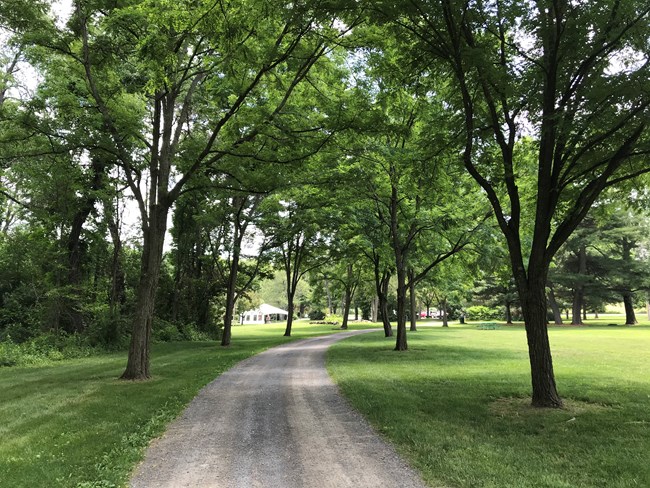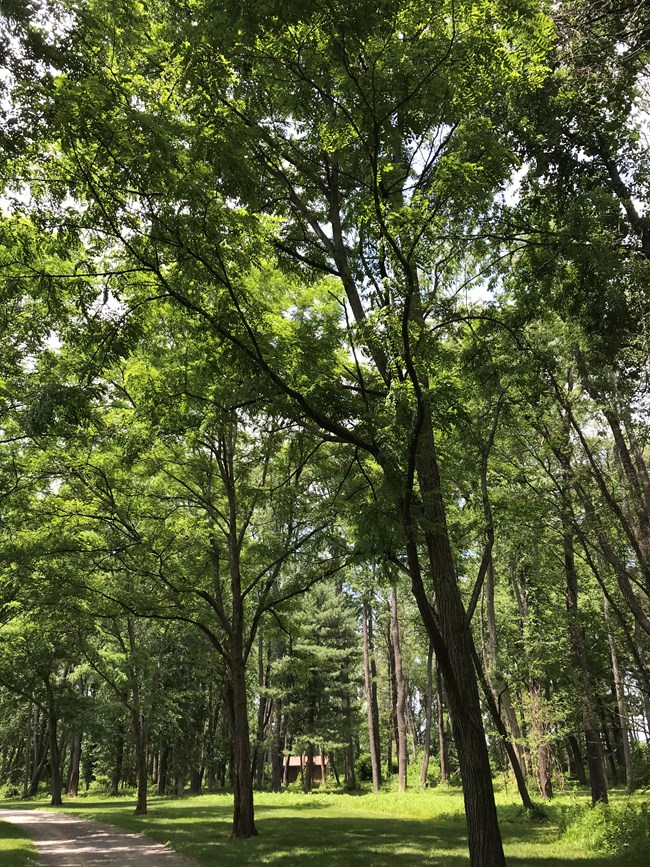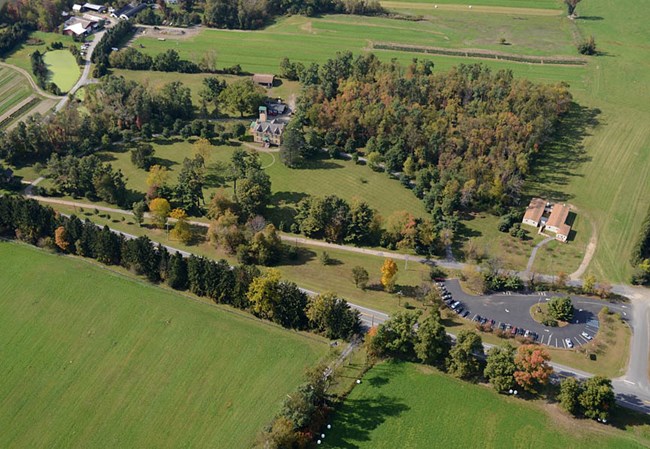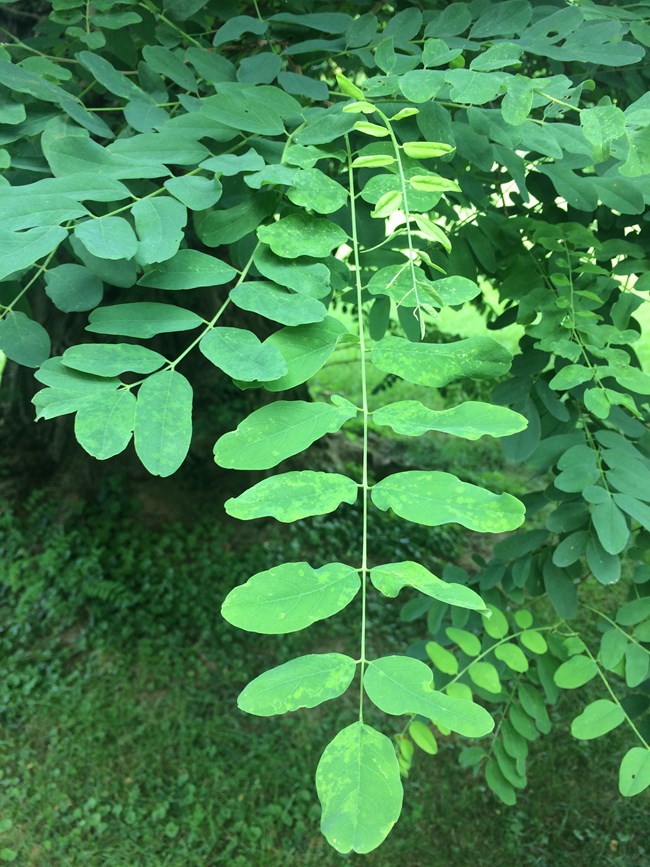Last updated: January 31, 2022
Article
Black Locust Allée at Martin Van Buren National Historic Site
Specimen Details

NPS / OCLP
-
Location: Martin Van Buren National Historic Site, Kinderhook, New York
-
Species: Black locust (Robinia pseudoacacia)
-
Landscape Use: Allée along entrance drive
-
Age: One historic tree is approximately 170 years old (planted c. 1850); 39 replacement trees are 20 years old (planted 2002)
-
Condition: Good
-
ID Number: Historic tree: ID #112, replacement trees: ID #253-293
-
Measurements: DBH of historic tree #112: 24 inches (2014)

NPS / OCLP
Significance

NPS / OCLP
How do we celebrate important trees? One way is through naming towns and other geographical locations after them. In the case of the black locust tree (Robinia pseudoaccacia), many American towns share its name. Visit New York, North Carolina, Pennsylvania, Delaware, Virginia, Oklahoma, Rhode Island, or Illinois and you might find yourself in Locustville, Locust Grove, or Locust Valley.
The namesake black locust has been important to the North American cultural landscape long before European colonial impacts. Yet today, this tree is not nearly as celebrated. In some regions and situations, it is illegal to plant black locusts due to their invasive growth traits. The complex ecological and social history of black locusts tells a fascinating story of how plants shape our landscapes, including national park sites.
In the 18th and 19th centuries, black locusts were widely planted due to their high-quality wood, appreciated not only in the United States but also in Europe. Author Donald Culross Peattie boasts of the black locust, “No other American tree has so extensive a foreign literature” (A Natural History of Trees, p. 417). Locust wood is even attributed with such feats as American victory against the British fleet on Lake Champlain in the War of 1812, due to the strength of locust nails and hulls used in American shipbuilding. Locusts were also used for ship masts, and a special variety of straight-trunked Shipmast locust was propagated in the Hudson Valley of New York for generations.

NPS / Martin Van Buren National Historic Site, photo #CLR-301

NPS / Martin Van Buren National Historic Site
This Hudson Valley regional culture of black locust cultivation may have influenced the planting of locusts at Lindenwald, the historic agricultural home of 8th U.S. President Martin Van Buren. Lindenwald is situated in the Hudson Valley, a mere five miles from the Hudson River. Van Buren named his estate after the linden trees that once populated the landscape, but the later planting of prominent black locust trees shows how this landscape was impacted by regional trends in horticulture and industry. Today, visitors to the home are greeted by a striking allée made up of black locust trees. This canopy follows the gracefully curving entrance drive to the main house, flanked by agricultural fields, lawn, and the sites of former orchards nearby. The original design for the locust allée is believed to date to the Van Buren era, installed during landscape improvements that the former president made in the early 1850s (Cultural Landscape Report Volume I, p. 33).
Van Buren moved to Lindenwald in 1841 after losing his bid for reelection. Van Buren followed a long line of former presidents who took up farming, and he was passionate about his agricultural landscape. During improvements to Lindenwald, Van Buren specified that his son, who would inherit the property, could alter only the buildings – the land was the domain of Van Buren himself. A leader in progressive farming, Van Buren was invested in long-term sustainability of his farm. He first grew and sold crops of hay, oats, and potatoes, and later expanded to other crops and livestock. Today, visitors to Lindenwald can experience the preserved landscape that Van Buren cared so deeply about, including the prominent black locust allée and preserved active agricultural fields which interpret the living history of this landscape.
Botanical Details

NPS / OCLP
Can a plant be both “invasive” and “native”? Many arboretums and state agencies advise against planting black locust due to invasive traits and aggressive spread. This creates an important opportunity to question assumptions about ecological labels of “invasive” and “native,” both of which can apply to black locusts. While many invasive species are non-native, black locusts are an example of a native invasive within certain regions of the United States. The native range of black locusts includes the Appalachian Mountains from Alabama and Georgia as far north as Ohio and Pennsylvania, with outlying pockets in Missouri, Arkansas, and Oklahoma (USFS).
Black locusts have a long history of spread and naturalization outside of their native range by both indigenous and colonial inhabitants. Black locust is not a traditional timber wood, but it is valued for bows, fence posts, ship building, and ornamental intrigue such as the Lindenwald Allée. When planted for these purposes outside of the native region, black locusts can negatively impact ecological diversity and outcompete other plants.
Locusts have the unusual characteristic of being in the legume (Fabaceae) family. Just like peas and beans (as well as redbud trees, acacia trees, and tamarind trees), black locusts are nitrogen-fixers. This means that they pull gaseous nitrogen from the air and convert it to soil nitrogen, a vital process in vegetable cultivation and the reason some farmers periodically plant legumes as cover crops. This fits with the innovative agricultural methods which are core to the history of Martin Van Buren National Historic Site; Van Buren was committed to preserving the long-term health and fertility of soil.
Van Buren’s progressive farming philosophy may reveal reasoning behind why these nitrogen-fixing trees were chosen for the allée at Lindenwald. Growth characteristics of locusts include thriving in nutrient-poor and disturbed soils and developing a deep root system that can protect against soil erosion, both traits that can assist with environmental remediation. Black locusts are prized for their aesthetic characteristics as well, including blue-green compound leaves which close slightly at night, strings of fragrant white flowers in the early summer which resemble wisteria, and sharp spines primarily on young growth. Van Buren was in good company among other former presidents who appreciated the characteristics of black locusts; George Washington planted a locust grove at his home, Mount Vernon.
Preservation Maintenance
At Lindenwald, the linear pattern in which the black locusts were planted is called an allée. A core characteristic of an allée is that it presents a uniform canopy, with trees of the same age, size, and structure flanking each side of a path. Allées present unique challenges to landscape preservation because as an allée grows, changes, and declines over time, the original design intent can be lost.
In the case of Lindenwald, it appears that some locusts along the allée were removed in the 1930s, and others were removed as they declined. Without the dominant canopy of the allée, the surrounding woodlots encroached and began to obscure the entrance drive. By the 1990s, the majority of the original locusts were missing, and the design intent of the allée was lost to time.
In preservation maintenance, a fascinating question of balance arises: Is it better to preserve the remaining historic trees within the allée, or preserve the overall character of the allée by replacing it in full with uniform new trees? This issue was considered by landscape architects and horticulturists within the National Park Service in the treatment plan for Lindenwald.
Martin Van Buren National Historic Site’s Cultural Landscape Report, Volume II, lays out a detailed treatment plan to replace and maintain the black locust allée:
To best represent the historic character of a uniform allée, the new trees should be reasonably equal to one another in size, creating a corridor space and enclosing the drive. All attempts should be made to maintain the locusts within the allée at a comparable size to one another through cyclic pruning. After planting, the cleared area of the ground plane should be seeded and maintained in a manner consistent with the front lawn.
The remaining historic black locust (#112) is the last tree on the north drive. Due to its location its mature size will not interrupt the corridor created by the replacement locust. The extant locust adds to the integrity and historic character of the site. During the implementation of this and other treatment tasks damage to the root system of the existing locust should be avoided. (pp. 19-20.)
Vegetation Removal and Restoration

Left image
Vegetation Removal Plan, gray shaded areas indicate removal (1997).
Credit: NPS / OCLP
Right image
Feature Restoration Plan, gray shaded circles along entrance drive indicate replacement locusts (1997).
Credit: NPS / OCLP

NPS / OCLP
Written in 1997, this detailed guidance was successfully implemented by 2002. As noted in the treatment recommendation, historic black locust #112 happened to be located at an end of the allée, thus not disrupting the aesthetics in the line of replacement locusts. To complete the allée of 40 trees, 39 replacement black locusts were planted at uniform intervals. A planting plan lays out center points, indicating that replacement trees were spaced 23’ apart, 15’ from the center line of the drive, on alternating sides.
A parallel example of a replacement effort for a historic black locust allée can be seen at Grey Towers National Historic Site, the Pennsylvania home of the first leader of the U.S. Forest Service and managed by that same agency. Installed in 1915 using mature trees dug from the Delaware River banks, the design intent was to be grand, stately, and aesthetic for receiving visitors. However, the trees struggled due to compaction and poor growing conditions, therefore an intensive replacement project was completed in 2011.
Today, the black locusts at Martin Van Buren National Historic Site evoke the historic allée that would have greeted guests to Lindenwald in the 19th century. Now mature, the replacement trees offer shade, elegance, and historical character. They are regularly pruned for both health and structure, and landscape staff monitor the surrounding ecosystem to minimize invasive spread.
Vegetation continuously grows and changes within historic landscapes, and periodic removal of overgrowth, or replacement of a designed feature such as an allée, allows a fresh start for historical interpretation and cyclical storytelling. What period in history will the allée convey when you visit?

NPS / OCLP
Discover More
- A Farmer in his Native Town: Cultural Landscape Report for the Martin Van Buren Farmland, Volume I (2004)
- Cultural Landscape Report for Martin Van Buren National Historic Site, Volume II (2016)
- Agricultural Management Guidelines for the Martin Van Buren National Historic Site (2018)
- Martin Van Buren NHS Landscape: Cultural Landscape Inventory (2013)
- Black Locust (Robinia pseudoacacia L.) - USDA Forest Service Southern Research Station
-
The Agricultural Landscape at Martin Van Buren National Historic Site (video)
- About the Martin Van Buren National Historic Site cultural landscape
